by Michael R. Allen
My latest commentary for St. Louis Public Radio of the same title aired today; read and listen to it here.
by Michael R. Allen
My latest commentary for St. Louis Public Radio of the same title aired today; read and listen to it here.
by Michael R. Allen
On September 25, the St. Louis Recorder of Deeds recorded the purchase of 17 parcels at Sheriff’s land tax auction by McEagle Properties shell holding company Union Martin LLC. McEagle’s companies had been dormant for several months.
Among the purchase are seven residential buildings, of which six are historic. Here they are, with purchase price in parentheses if reported:
Why do I mention the purchase prices? I want to impress upon readers how easy it would be for other buyers to compete at the Sheriff’s auctions for these properties. Community development corporations, neighborhood associations and other that want to keep out large-scale acquisition would do well to get some money together and head to the Sheriff’s auction. Every month, dozens of north side parcels — and historic buildings — sell to speculators for low, low prices.
These acquisitions illustrate the thorniness of preservation planning in the NorthSide project. A week ago, preservationists thought they knew the pool from which the list of buildings to be rehabilitated would be drawn. In one day, that pool expanded. However, these buildings are in good shape and will be around for awhile. McEagle need not fear that preservationists have immediate demands beyond simply keeping these buildings from falling until there is a solid plan.
The remaining parcels recently purchased by Union Martin are located at 2516, 2518-20 and 2526 Slattery Avenue, 2930 James Cool Papa Bell (nee Dickson) Avenue, 2524 Coleman Street and 2832 Cass Avenue in JeffVanderLou; 3244 Knapp Street in Old North St. Louis; 2561 Hebert Street, 2231 and 2236 Benton Street and 1947-51 Wright Street in St. Louis Place.
by Michael R. Allen
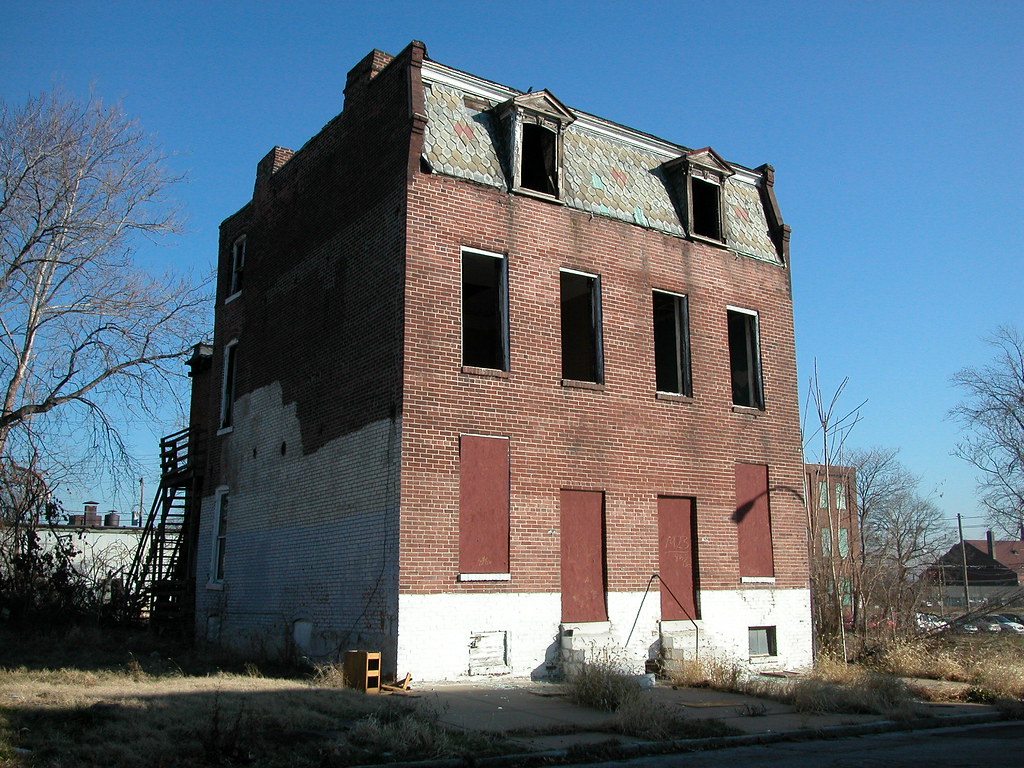 Sure, the house at 1925-27 Madison Street in St. Louis Place had its front wall rebuilt in a 1950s brick that clashes with its 19th century slate mansard. Yes, its immediate neighbors were gone when I took the above photograph in 2006. Still the old house was solid as one of its wall bricks and close to the dense cluster of redeveloped property around the Falstaff Brewery at 20th and Madison. To boot, the house was included as a contributing resource to the Clemens House-Columbia Brewery Historic District, so rehabbing this building could land someone — like its owner, McEagle Properties — historic tax credits.
Sure, the house at 1925-27 Madison Street in St. Louis Place had its front wall rebuilt in a 1950s brick that clashes with its 19th century slate mansard. Yes, its immediate neighbors were gone when I took the above photograph in 2006. Still the old house was solid as one of its wall bricks and close to the dense cluster of redeveloped property around the Falstaff Brewery at 20th and Madison. To boot, the house was included as a contributing resource to the Clemens House-Columbia Brewery Historic District, so rehabbing this building could land someone — like its owner, McEagle Properties — historic tax credits.
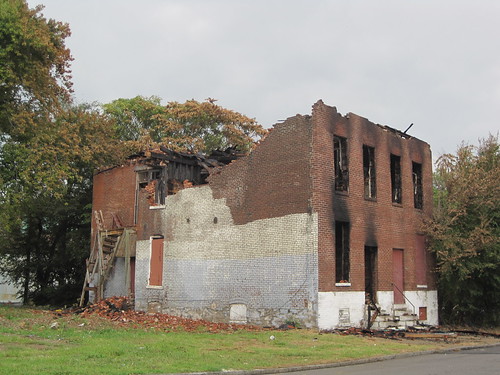 The happy ending never came. On early Monday morning, September 21, a blaze consumed the building causing severe damage. Strangely, the city’s Building Division had recently boarded all of the building’s first floor doors and windows with the red composite boards now being used.
The happy ending never came. On early Monday morning, September 21, a blaze consumed the building causing severe damage. Strangely, the city’s Building Division had recently boarded all of the building’s first floor doors and windows with the red composite boards now being used.
On the night of the Tax Increment Financing (TIF) Commission advisory vote on the first part of McEagle’s NorthSide TIF, I left the meeting early after not being able to get inside. I drove up to check out the damage, which had been reported on KTVI. I came across a man picking intact bricks out of the rubble. At the curb was a car without plates or a dealer’s sticker. I called 911.
Rehabbers Club Tour of Old North and St. Louis Place
Saturday, September 19, 2009
9:30 a.m.
Meet at 3001 Rauschenbach
ReVitalize St. Louis’ September Rehabbers Club will feature north St. Louis neighborhoods. There is a rich history and continued strength in these neighborhoods. We’ll explore St. Louis Place and Old North.
We will gather at 3001 Rauschenbach Ave. This 3-story home was built in the late 1800’s by a tobacco merchant. Over the years it was used for institutional purposes
(halfway house for boys, pregnant single women, etc). Its current owner has been restoring the home back to its original grandeur. There are 4 marble fireplaces on the first floor along and near all of the original woodwork and pocket doors are intact.
Next we’ll head over to 2223 St. Louis Ave. This for-sale-property is a rehab opportunity. While the main house was built in 1879, the building was expanded in 1921 by the Henry Leidner Undertaking Company. Over the years it has been the Victory Baptist Church and then the Bible Way Church. Bible Way moved out in 2006 and is looking for a rehabber to purchase the building. Reverend Harsley will lead a tour of the structure and provide additional historical information as well as spec’s on the sale of the building.
One stop is a historical review of the James Clemens Mansion located at 1849 Cass Ave.
Michael Allen, an architectural historian and blogger for Ecology of Absence will share the history of the mansion and discuss its current state.
Just added to the tour is a full-rehabbed house at 1411 Hebert Street in Old North, currently up for sale.
We look forward to seeing you on Saturday morning. Call Scott McIntosh, ReVitalize St. Louis Programming Chair at 314-719-6507 with questions.
by Michael R. Allen
 Over a week ago, gaping hole appeared in the front yard wall at the James Clemens, Jr. House (1849 Cass Avenue in St. Louis Place). The cause of the collapse was structural failure, but the hole and its resulting brick debris attracted a truck load of thieves warded away by vigilant neighbors. Since the wall’s partial collapse, the hole has attracted photographer, a television news crew, concerned neighbors and property owners, thieves and — not surprising — no maintenance crews from Clemens House owner McEagle properties.
Over a week ago, gaping hole appeared in the front yard wall at the James Clemens, Jr. House (1849 Cass Avenue in St. Louis Place). The cause of the collapse was structural failure, but the hole and its resulting brick debris attracted a truck load of thieves warded away by vigilant neighbors. Since the wall’s partial collapse, the hole has attracted photographer, a television news crew, concerned neighbors and property owners, thieves and — not surprising — no maintenance crews from Clemens House owner McEagle properties.
The wall remains breached, and the brick bats piled behind the breach right where they fell. When McEagle’s representatives talk about saving the Clemens House, what do they mean? A June draft of the revised tax increment financing (TIF) application for the NorthSide project showed an $8.6 million budget for rehabilitation of the Clemens House — in the project’s second phase with no item for repairs in the first phase — with 100% of the funds to come from TIF funds (at least prior to historic tac credit reimbursement).
While the final TIF application due out tomorrow may not include that line item, the draft idea is discouraging. What if the TIF does not pass the Board of Aldermen, or what if it passes without city backing and McEagle cannot monetize the TIF? The most pressing point is that there is no indication that structural issues like this fence failure or last year’s chapel wall and roof collapse will be abated before TIF funds are available.
 This photograph of the wall that I took before the collapse shows the massive inward bow of the wall. The wall’s weight load was shifted askew. Additionally, the wall is tuckpointed incorrectly with a hard mortar, which forces moisture weeping through the bricks instead of the mortar joints. Over times, the bricks in the bow have split due to shifted weight load’s resulting stress, and have been weakened by the hard mortar. A collapse was building.
This photograph of the wall that I took before the collapse shows the massive inward bow of the wall. The wall’s weight load was shifted askew. Additionally, the wall is tuckpointed incorrectly with a hard mortar, which forces moisture weeping through the bricks instead of the mortar joints. Over times, the bricks in the bow have split due to shifted weight load’s resulting stress, and have been weakened by the hard mortar. A collapse was building.
 Of course, this is not the first part of the wall to fall. The limestone return of wall on the east is missing, all of the way through the corner at Cass Avenue.
Of course, this is not the first part of the wall to fall. The limestone return of wall on the east is missing, all of the way through the corner at Cass Avenue.
 There is also a partly-collapsed section in front of the chapel at this end. This section collapsed in 2005.
There is also a partly-collapsed section in front of the chapel at this end. This section collapsed in 2005.
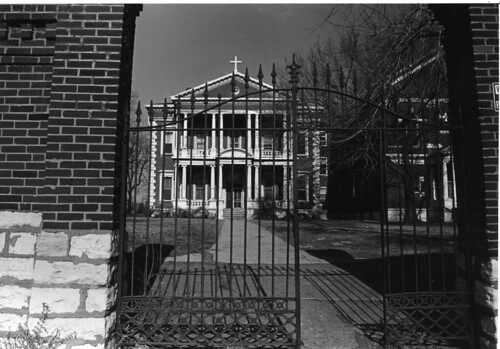 A central feature of the wall was the wrought iron gates, crudely removed by a thief after the Berean Missionary Baptist Association vacated the Clemens House in 2000. This photograph comes from the Landmarks Association of St. Louis and dates to 1980.
A central feature of the wall was the wrought iron gates, crudely removed by a thief after the Berean Missionary Baptist Association vacated the Clemens House in 2000. This photograph comes from the Landmarks Association of St. Louis and dates to 1980.
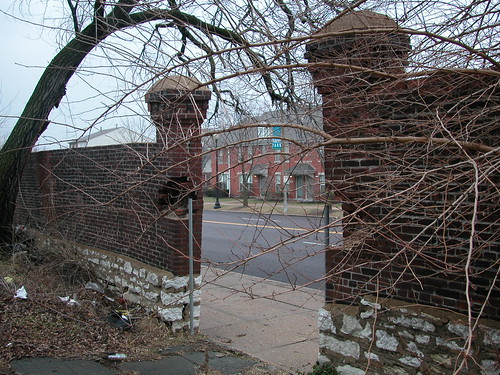 Here’s the reverse view in early 2008, showing the damage to the wall caused by hasty removal. My guess is that the thieves tied each gate to a pick-up truck, and pulled them off by accelerating. Perhaps the gates were mangled in the process and ended up in the scrap yard instead of the salvage shop. (Any dealer who accepted and then sold these gates deserves prison time, by the way.)
Here’s the reverse view in early 2008, showing the damage to the wall caused by hasty removal. My guess is that the thieves tied each gate to a pick-up truck, and pulled them off by accelerating. Perhaps the gates were mangled in the process and ended up in the scrap yard instead of the salvage shop. (Any dealer who accepted and then sold these gates deserves prison time, by the way.)
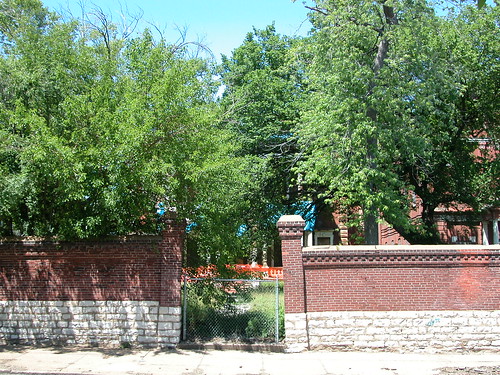 So now the Clemens House sits behind an unstable, damaged high brick wall missing its iron gates.
So now the Clemens House sits behind an unstable, damaged high brick wall missing its iron gates.
 Once upon a time, back in 1860 when this silver albumen print was made, the mansion sat behind an elegant iron fence. The iron fence was low and afforded great views of the majestic house. The fence ended at the wooden fencing that surrounded the rest of the Clemens estate.
Once upon a time, back in 1860 when this silver albumen print was made, the mansion sat behind an elegant iron fence. The iron fence was low and afforded great views of the majestic house. The fence ended at the wooden fencing that surrounded the rest of the Clemens estate.
Preservation of the Clemens House need not retain the later brick wall, which suffers disrepair and obscured views of the house and its later chapel addition. One possible plan would be demolition of the later brick wall and replication of the original iron fence, would would reconnect the Clemens House to the Cass Avenue streetscape and surroudning neighborhood.
However, the fence plan would have to be made as part of a total preservation plan for the site that would take into account use of historic tax credit programs that come with review guidelines that may necessitate retention of the existing wall. To date, there has been no preservation plan produced for the Clemens House — no historic structures report, no structural assessment, nothing. Until McEagle produces a plan, the brick wall needs to be stabilized. The breaches should be closed, and the wall should be braced. If the wall comes down, that act should be planned.
For now, the gaping hole stands as naked testament to the lack of planning for the future of the Clemens House. I want the house to be saved, and I want McEagle to make preservation a priority that is not tied to the outcome of the TIF financing. The Clemens House remains one of the city’s most important 19th century buildings, and its fate truly is of regional concern. McEagle should fix the wall and then work on a serious preservation plan with stabilization work occurring in the first phase of the NorthSide project. Can you imagine a better good will gesture than prompt maintenance and early stabilization? Once stabilized, as the Mullanphy Emigrant Home demonstrates, a building will buy significant time for reuse planning. No preservationist that I know is hollering for McEagle to reopen a fully-restored Clemens House immediately. We just want to make sure than no part of it — including the chapel, which is not far gone despite visible damage — falls down.
by Michael R. Allen
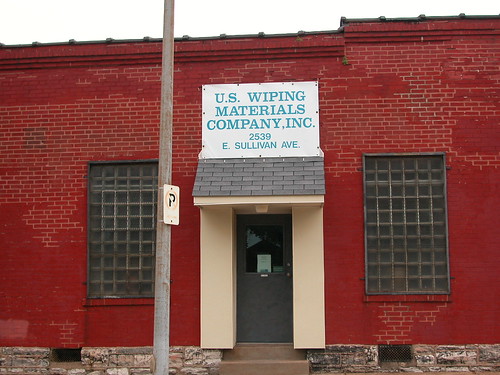 The website of St. Louis’ own U.S. Wiping Materials Company, Inc. boasts that the company “has been in business for over 100 years. Being centrally located in St. Louis Missouri has allowed us the ability to provide cost-effective shipping in a timely manner to all of North America.”
The website of St. Louis’ own U.S. Wiping Materials Company, Inc. boasts that the company “has been in business for over 100 years. Being centrally located in St. Louis Missouri has allowed us the ability to provide cost-effective shipping in a timely manner to all of North America.”
The central location for U.S. Wiping Material, manufacturer and distributor of towels, rags and wipers of all kinds, is a one-story brick industrial building at 2539 East Sullivan Avenue in St. Louis Place. Built in 1914, the building is a sturdy home to the company.
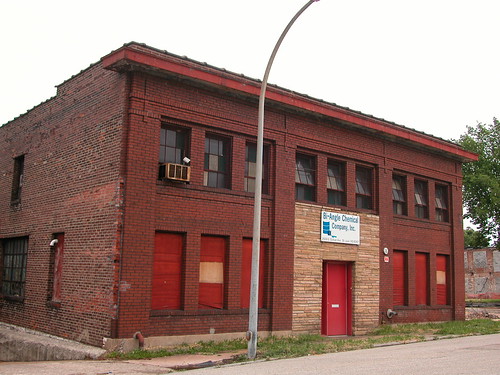 Next door to U.S. Wiping is the Bi-Angle Chemical Company, Inc. at 2531 East Sullivan Avenue. This plastics company is located in a handsome two-story Craftsman-style building built in 1916. The workforce is not huge, but workers can be seen all day on the back docks taking their breaks.
Next door to U.S. Wiping is the Bi-Angle Chemical Company, Inc. at 2531 East Sullivan Avenue. This plastics company is located in a handsome two-story Craftsman-style building built in 1916. The workforce is not huge, but workers can be seen all day on the back docks taking their breaks.
U.S. Wiping and Bi-Angle are located on a fairly deserted block between extra-wide Parnell Avenue and 25th Street, where Sullivan dead-ends at the Sullivan Place apartment complex. These companies’ building are located within the proposed boundaries of McEagle’s NorthSide project. While just outside of the boundary of one of the developer’s proposed “employment centers,” these employers may not be safe. A slide shown by McEagle on May 21, 2009 at Central Baptist Church shows these two building demolished. At the same meeting, McEagle chief Paul J. McKee, Jr. promised that McEagle would not move “a single job” out of the project area.
Of course, these companies might voluntarily sell to McEagle — but that would mean the loss of jobs in the heart of St. Louis Place, a move the developer says it wants to avoid. U.S. Wiping and Bi-Angle provide jobs, pay earnings and real estate taxes and hold down the fort on a lonely block. These companies and their buildings should be retained as part of the new development, not courted for departure.
 To the south, Hopmann Cornice Company faces destruction for the NorthSide project (see “What Happens to Hopmann Cornice?”, June 3, 2009). Located on Benton Avenue between Parnell and Jefferson, Hopmann is located in a southern tail of the proposed “employmenmt center” and Benton Street is proposed for removal. While Hopmann employs a very small number of employees — as few as two at times — this is a family-owned business providing a highly specialized craft. The Hopmanns have survived in St. Louis Place since 1880, and their eviction would be a tragic end to a proud family legacy.
To the south, Hopmann Cornice Company faces destruction for the NorthSide project (see “What Happens to Hopmann Cornice?”, June 3, 2009). Located on Benton Avenue between Parnell and Jefferson, Hopmann is located in a southern tail of the proposed “employmenmt center” and Benton Street is proposed for removal. While Hopmann employs a very small number of employees — as few as two at times — this is a family-owned business providing a highly specialized craft. The Hopmanns have survived in St. Louis Place since 1880, and their eviction would be a tragic end to a proud family legacy.
As a family-owned business, McEagle ought to be sympathetic to Hopmann Cornice and work around its small-footprint shop. After all, if the goal of NorthSide is to provide multi-acre business sites, how would retention of a 0.17-acre site impede any of the project goals? (The U.S. Wiping and Bi-Angle sites are 0.496 acres and 0.16 acres, respectively.)
by Michael R. Allen
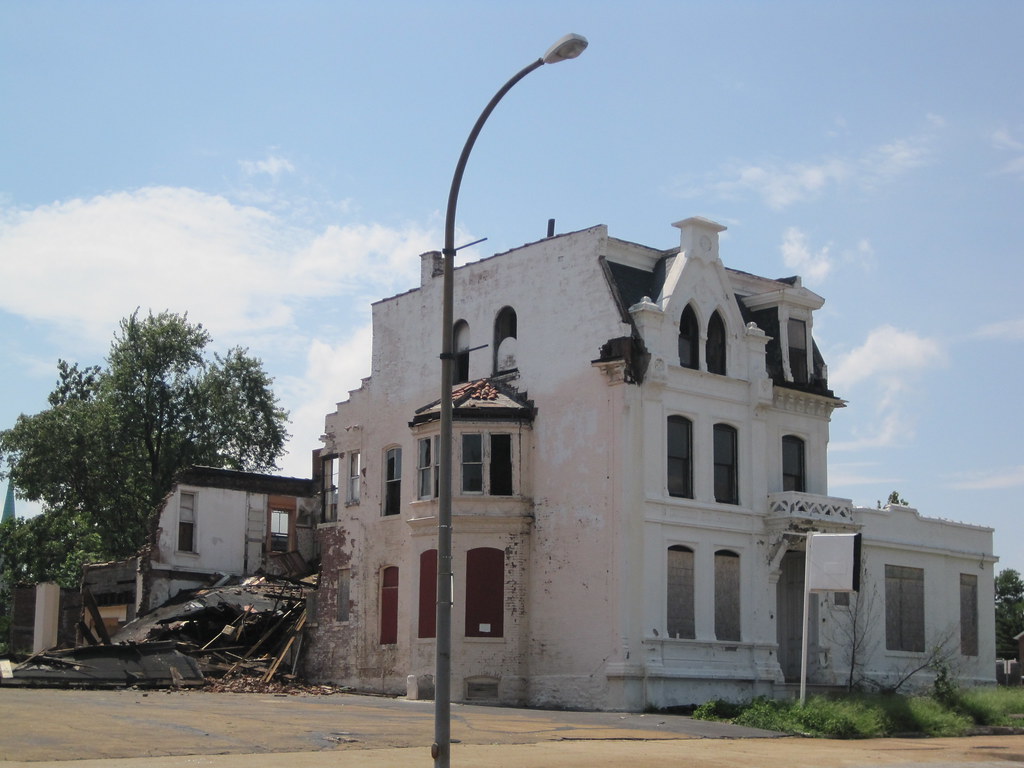 Criminals can work pretty damn fast, as the condition of the McEagle Properties-owned house at 1930-6 St. Louis Avenue shows. Two weeks ago, the vacant house was sound. Last Wednesday, the side wall had started to come down at the hands of the north side vultures (see “The Precarious Condition of Two Houses on St. Louis Avenue,” (August 12, 2009). Today, almost all of the ell of the old house stood destroyed. The bricks no doubt have cycled through Pope’s or one of the other yards around 25th and University, then on to hands more legally clean of fencing stolen goods but no less complicit.
Criminals can work pretty damn fast, as the condition of the McEagle Properties-owned house at 1930-6 St. Louis Avenue shows. Two weeks ago, the vacant house was sound. Last Wednesday, the side wall had started to come down at the hands of the north side vultures (see “The Precarious Condition of Two Houses on St. Louis Avenue,” (August 12, 2009). Today, almost all of the ell of the old house stood destroyed. The bricks no doubt have cycled through Pope’s or one of the other yards around 25th and University, then on to hands more legally clean of fencing stolen goods but no less complicit.
Meanwhile, McEagle has taken no visible step to safeguard the over 150 historic buildings that it owns in north St. Louis, or work with residents to report brick thieves, who prey also on other buildings. Perhaps no one has seen the activity here. After all, thieves picked apart many buildings to the south of this house, McEagle emptied the three houses to the east of this building and two of the three buildings across the street is vacant. Four years ago, the brick thieves would have been afraid to pick on this block, and now they seem to be able to rule the roost.
However, what is done is done. Complaining about the past won’t secure a future for the McEagle-owned historic buildings across north city. What will do the trick is actual preservation planning: architectural survey of St. Louis Place and JeffVanderLou, listing of eligible buildings and districts, placement of the 5th and 19th wards in preservation review (solely the responsibility of the alderwomen) and strict rules about security and stabilization as part of the redevelopment ordinances facing the Board of Aldermen. If McEagle and planner Mark Johns of Civitas are serious about saving “legacy properties,” it’s time to tell us how they will do that.
The facts on one hand: Brick thieves demolishing McEagle buildings. Historic buildings deteriorating and left open to the elements. On the other: A promise. Promises don’t save historic buildings, or we’d all be rehabbers. I don’t mean to condone or chastise McEagle for the past failures, but urge the developer and city leaders to take action now as part of the negotiation. If McEagle lacks the capacity, then it should work openly with the city and other developers who can bring funds for preservation planning, stabilization and rehabilitation. We can’t save everything, and we’ve lost a lot. (We lost more in St. Louis Place and JeffVanderLou before McEagle arrived, in fairness.) Yet we can take the circumstances we have and turn a developer’s promise into action that will reassure residents of north St. Louis that McEagle is as serious about the attempt as it is about the sell.
by Michael R. Allen
 Brick rustlers have returned to the lovely stone-faced house at 1930-6 St. Louis Avenue (see ““Who Would Destroy This Building?”, January 7, 2007). Most recently a funeral home, the house was first built in 1873 by wholesale grocery merchant Bernhardt Winkelman. Winkelman was one of the numerous new-money German-Americans whose lavish homes gave St. Louis Avenue the nickname “Millionaire’s Row.” Today, a different millionaire owns the property: developer Paul J. McKee, Jr. through holding company N & G Ventures.
Brick rustlers have returned to the lovely stone-faced house at 1930-6 St. Louis Avenue (see ““Who Would Destroy This Building?”, January 7, 2007). Most recently a funeral home, the house was first built in 1873 by wholesale grocery merchant Bernhardt Winkelman. Winkelman was one of the numerous new-money German-Americans whose lavish homes gave St. Louis Avenue the nickname “Millionaire’s Row.” Today, a different millionaire owns the property: developer Paul J. McKee, Jr. through holding company N & G Ventures.
 The damage from 2007 concerned only a one-story flat-roofed addition behind the home, but this week’s damage concerns the side wall of part of the house. Since joists run laterally and rest in the brick side walls of most 19th century buildings, this damage will eventually cause collapse of the roof and floors. However, the thieves have only struck an addition to the Winkelmann house’s ell, so the original section is not yet damaged.
The damage from 2007 concerned only a one-story flat-roofed addition behind the home, but this week’s damage concerns the side wall of part of the house. Since joists run laterally and rest in the brick side walls of most 19th century buildings, this damage will eventually cause collapse of the roof and floors. However, the thieves have only struck an addition to the Winkelmann house’s ell, so the original section is not yet damaged.
On May 21 and other occasions, McKee mentioned having a list of 60 “legacy properties” in his possession worthy of preservation. Is this house one of them? It should be. However, the list is a mystery to myself and many people in city government and the development world with whom I have discussed preservation issues related to the NorthSide project. We do know that the house at 1930 St. Louis Avenue made an official list that gives it undisputed historic status: the house is a contributing resource to the Clemens House-Columbia Brewery Historic District. It ought to be preserved, and McKee should secure it against further attack.
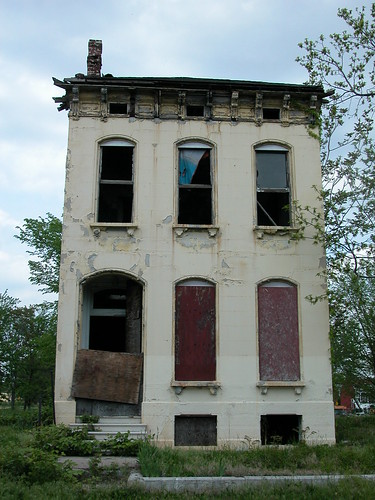 Across the street is another fine stone-faced house with a lovely wooden Italianate cornice. The house at 1925 St. Louis Avenue dates to 1879 and is owned by the city’s Land Reutilization Authority (LRA). The house is outside of the present historic district boundary. The front looks ragged but sturdy, but a walk around the side reveals the sad truth.
Across the street is another fine stone-faced house with a lovely wooden Italianate cornice. The house at 1925 St. Louis Avenue dates to 1879 and is owned by the city’s Land Reutilization Authority (LRA). The house is outside of the present historic district boundary. The front looks ragged but sturdy, but a walk around the side reveals the sad truth.
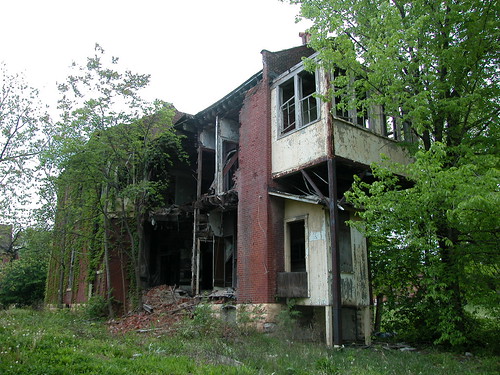 The east side wall of the ell is in shambles, although the second floor and roof are holding on for now. The condition of this house raises a preservation question related to NorthSide that has not been widely discussed: what happens to the numerous vacant historic buildings within the NorthSide footprint not owned by McEagle Properties and its subsidiaries? Most of those buildings are on the list of needed properties that McEagle submitted to the city’s Tax Increment Financing Commission in May. Is the building at 1927 St. Louis Avenue one of the 60 “legacy properties”? There are more than 60 historic buildings owned by McEagle worthy of preservation, and at least as many in the project area owned by LRA and other entities.
The east side wall of the ell is in shambles, although the second floor and roof are holding on for now. The condition of this house raises a preservation question related to NorthSide that has not been widely discussed: what happens to the numerous vacant historic buildings within the NorthSide footprint not owned by McEagle Properties and its subsidiaries? Most of those buildings are on the list of needed properties that McEagle submitted to the city’s Tax Increment Financing Commission in May. Is the building at 1927 St. Louis Avenue one of the 60 “legacy properties”? There are more than 60 historic buildings owned by McEagle worthy of preservation, and at least as many in the project area owned by LRA and other entities.
City officials should not wait for the list of legacy properties to set into motion a sensible preservation plan for the NorthSide project. If public financing is on the table, that can be leveraged to ensure that buildings like the two above can be mothballed for eventual redevelopment in future phases of the NorthSide project.
by Michael R. Allen
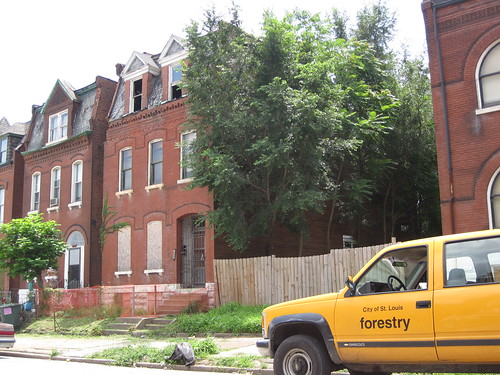 A worker from the city Forestry Division was out today cutting weeds in front of the house locates at 2004 North Market Street in St. Louis Place. That vacant historic house and the lot to the west are owned by N & G Ventures LC, a holding company controlled by McEagle Properties.
A worker from the city Forestry Division was out today cutting weeds in front of the house locates at 2004 North Market Street in St. Louis Place. That vacant historic house and the lot to the west are owned by N & G Ventures LC, a holding company controlled by McEagle Properties.
Last summer, McEagle hired Marvin Steele to coordinate maintenance on its inventory of around 1,000 vacant properties in north St. Louis. Steele set up a new company, Urban Solutions, to handle the maintenance work, placed signs around JeffVanderLou and St. Louis Place with his company’s hot-line number (946-7333) and promised to handle citizen complaints within 48 hours. After a big initial push to get work done last summer and fall, Urban Solutions seems to have withered like a weed doused with RoundUp.
McEagle and Steele’s actions came after intense complaints from north side residents about McEagle’s inaction on maintenance and reliance on city government services to handle citizen complaints. Also, in August 2007, the Missouri General Assembly revised the Distressed Areas Land Assemblage Tax Credit Act before passage to forbid use of the credit to cover payments to municipal government for remediation of code violations like high weeds and unboarded windows.
At a public meeting on May 21, McEagle disclosed that the company has spent $1.4 million to date on maintenance of north side holdings. At the same meeting, McEagle revealed that some sections of its proposed “NorthSide” project may not be developed until after 2016 or later, sparking renewed concerns about long-term maintenance problems.
Meanwhile, residents continue to deal with the high weeds and unboarded boards the way that they always have: by calling the Citizens’ Service Bureau, which dispatches the resources of city government. City government fronts the bill, and McEagle pays the city. The city collects a mark-up fee, sure. Yet the cycle is not comforting to residents who have to wait for city codes to be broken and their blocks to look bad before they can get action. These people have every right to be skeptical that McEagle deserves a $400 million tax increment financing package with city backing as well as development rights to an area the developer can’t seem to keep under control.
If the developer and City Hall want to make the deal look better to residents, making the properties look better is a great step. If Urban Solutions cannot handle the job, McEagle should hire a company that can do the job with diligence. Look at the house in the photograph above. Here’s the needed work:
– cut down the trees and woody growth along the side wall
– board up the third floor (at least) and second floor windows
– install temporary plastic cutter trough and elbow on front elevation
Perhaps McEagle considers the installation of temporary guttering to be more than maintenance, but it is needed to keep the house standing. The other items are basic, and would take less than a half-day. (Really, cutting overgrowth and boarding windows are among the first skills a rehabber learns.)
Since maintenance costs incurred privately are covered by the DALATC, then there is no reason at all for McEagle not to spend the necessary money to address maintenance needs. With a project timeline extending to 2030, good maintenance will be needed for a long time — and the sooner it starts, the better. Forestry can’t do it all.
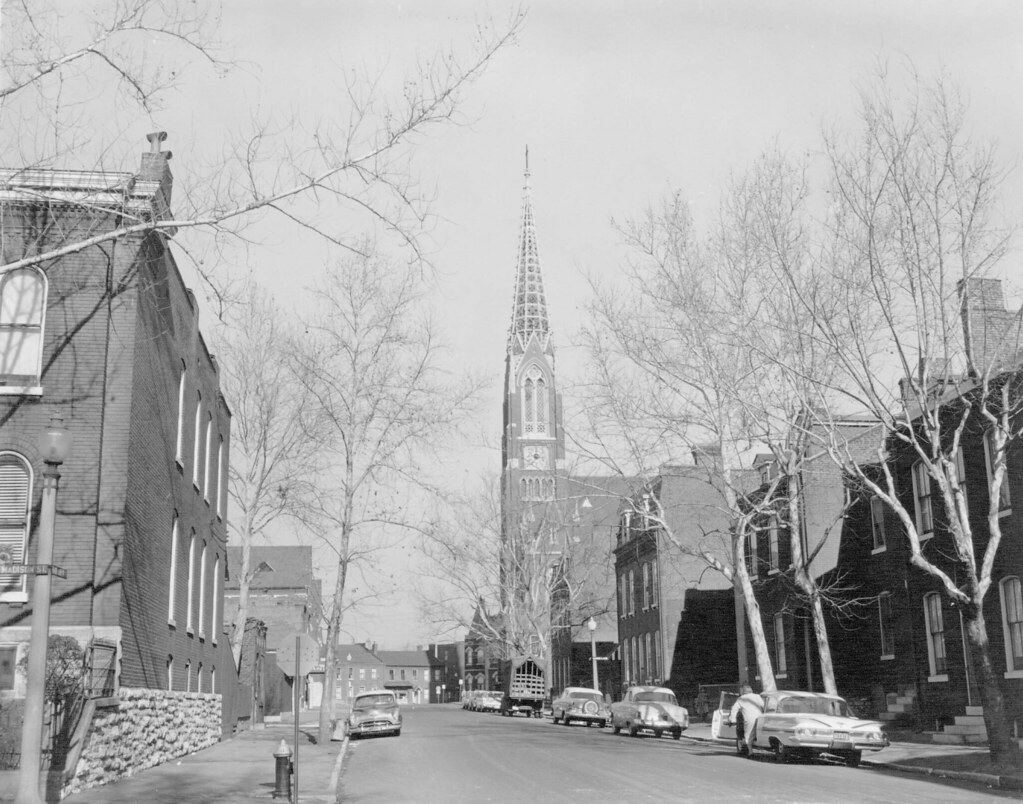 Here’s a 1960 view of Hogan Street looking north from Madison in St. Louis Place. The density of brick houses is striking. Also notable is the open-work sandstone spire on St. Liborius Roman Catholic Church, which would be removed in 1965.
Here’s a 1960 view of Hogan Street looking north from Madison in St. Louis Place. The density of brick houses is striking. Also notable is the open-work sandstone spire on St. Liborius Roman Catholic Church, which would be removed in 1965.
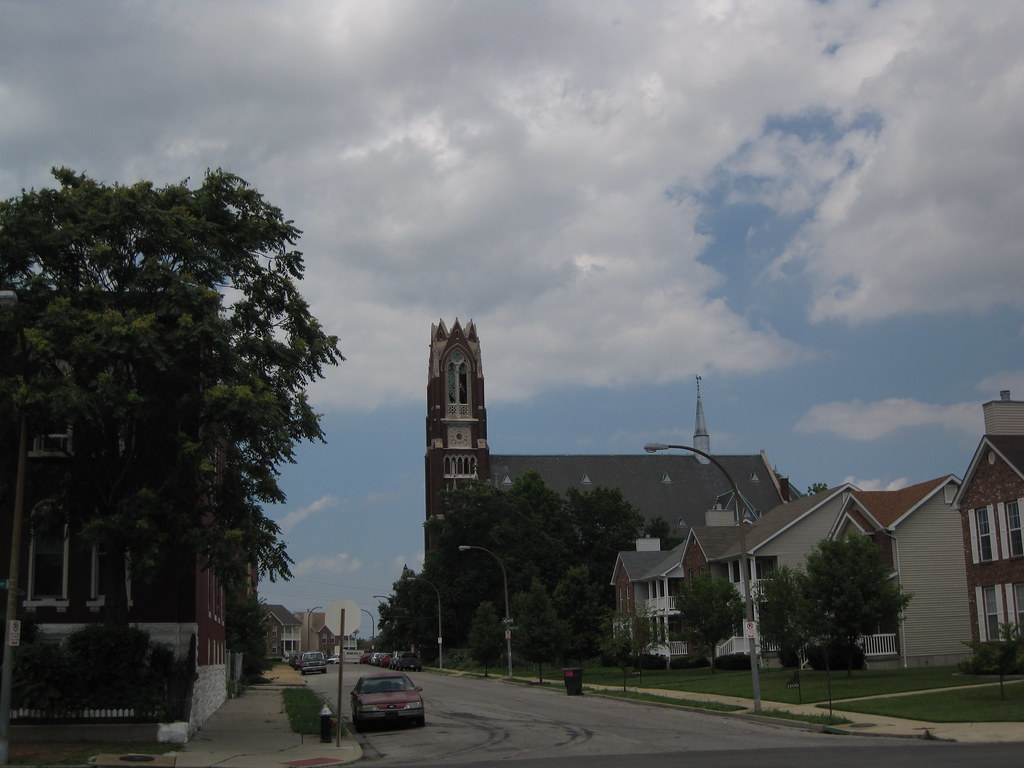 This is the same view today. The house at the corner and its stone wall remain, as does St. Liborius church. The brick houses and tenements are gone, replaced by new houses and (not visible here, but adjacent to the church) the New Roots Farm.
This is the same view today. The house at the corner and its stone wall remain, as does St. Liborius church. The brick houses and tenements are gone, replaced by new houses and (not visible here, but adjacent to the church) the New Roots Farm.